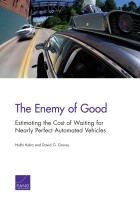| 来源类型 | Research Reports
|
| 规范类型 | 报告
|
| DOI | https://doi.org/10.7249/RR2150
|
| ISBN | 9780833099372
|
| 来源ID | RR-2150-RC
|
| The Enemy of Good: Estimating the Cost of Waiting for Nearly Perfect Automated Vehicles |
| Nidhi Kalra; David G. Groves
|
| 发表日期 | 2017
|
| 出版年 | 2017
|
| 页码 | 54
|
| 语种 | 英语
|
| 结论 |
Results Suggest That More Lives Will Be Saved the Sooner HAVs Are Deployed- We used the RAND Model of Automated Vehicle Safety to compare road fatalities under (1) a policy that allows HAVs to be deployed for consumer use when their safety performance is just 10 percent better than that of the average human driver (Improve10) and (2) a policy that waits to deploy HAVs only once they have reached significant performance improvements of 75 percent or 90 percent (Improve75 or Improve90).
- We find that, in the short term, more lives are cumulatively saved under a more permissive policy (Improve10) than stricter policies requiring greater safety advancements (Improve75 or Improve90) in nearly all conditions, and those savings can be significant — hundreds of thousands of lives.
- In the long term, more lives are cumulatively saved under an Improve10 policy than either Improve75 or Improve90 policies under all combinations of conditions we explored. In many cases, those savings can be more than half a million lives.
- There is good reason to believe that reaching significant safety improvements may take a long time and may be difficult prior to deployment. Therefore, the number of lives lost while waiting for significant improvements prior to deployment may be large.
|
| 摘要 |
- This evidence could help decisionmakers to better balance public skepticism with evidence about the human cost of different choices and to set policies that save more lives overall. Deploying HAVs when their safety performance is just better than that of the average human driver may be too permissive given social expectations about the safety of robots, machines, and other automated systems, but waiting for improvements many times over or waiting for perfection may be too costly. Instead, a middle ground of HAV performance requirements may prove to save the most lives overall.
|
| 主题 | Autonomous Vehicles
; Passenger Traffic
; Traffic Accidents
; Transportation Safety
|
| URL | https://www.rand.org/pubs/research_reports/RR2150.html
|
| 来源智库 | RAND Corporation (United States)
|
| 引用统计 |
|
| 资源类型 | 智库出版物
|
| 条目标识符 | http://119.78.100.153/handle/2XGU8XDN/108679
|
推荐引用方式
GB/T 7714 |
Nidhi Kalra,David G. Groves. The Enemy of Good: Estimating the Cost of Waiting for Nearly Perfect Automated Vehicles. 2017.
|
|
文件名:
|
x1540240421078.jpg
|
|
格式:
|
JPEG
|

|
文件名:
|
RAND_RR2150.pdf
|
|
格式:
|
Adobe PDF
|
除非特别说明,本系统中所有内容都受版权保护,并保留所有权利。